University Report: Mergers and Acquisitions and Business Strategies
VerifiedAdded on 2020/03/23
|24
|5922
|62
Report
AI Summary
This report offers a comprehensive analysis of mergers and acquisitions (M&A), exploring their dynamics through the summarization of chapters from a book on the topic. It details conditions, types (horizontal, vertical, conglomerate), and the nine key reasons behind M&A, including financial instability and market expansion. The report delves into the principles and stages of M&A, along with reasons for failures. Chapter summaries cover topics such as Warner Music Group's restructuring, exit strategies, and global market entry. The report examines the significance of synergic value, risk mitigation, and the importance of strategic decision-making in M&A. It also discusses various exit strategies like divestitures, spin-offs, and equity carve-outs, alongside the factors influencing cross-border M&A. The analysis provides a deeper insight into restructuring activities and their role in maximizing shareholder value, including critical analysis of settlement theories and court proceedings related to bankruptcy. The report emphasizes the importance of adaptability, rational thinking, and strategic vision in ensuring the success of mergers and acquisitions.
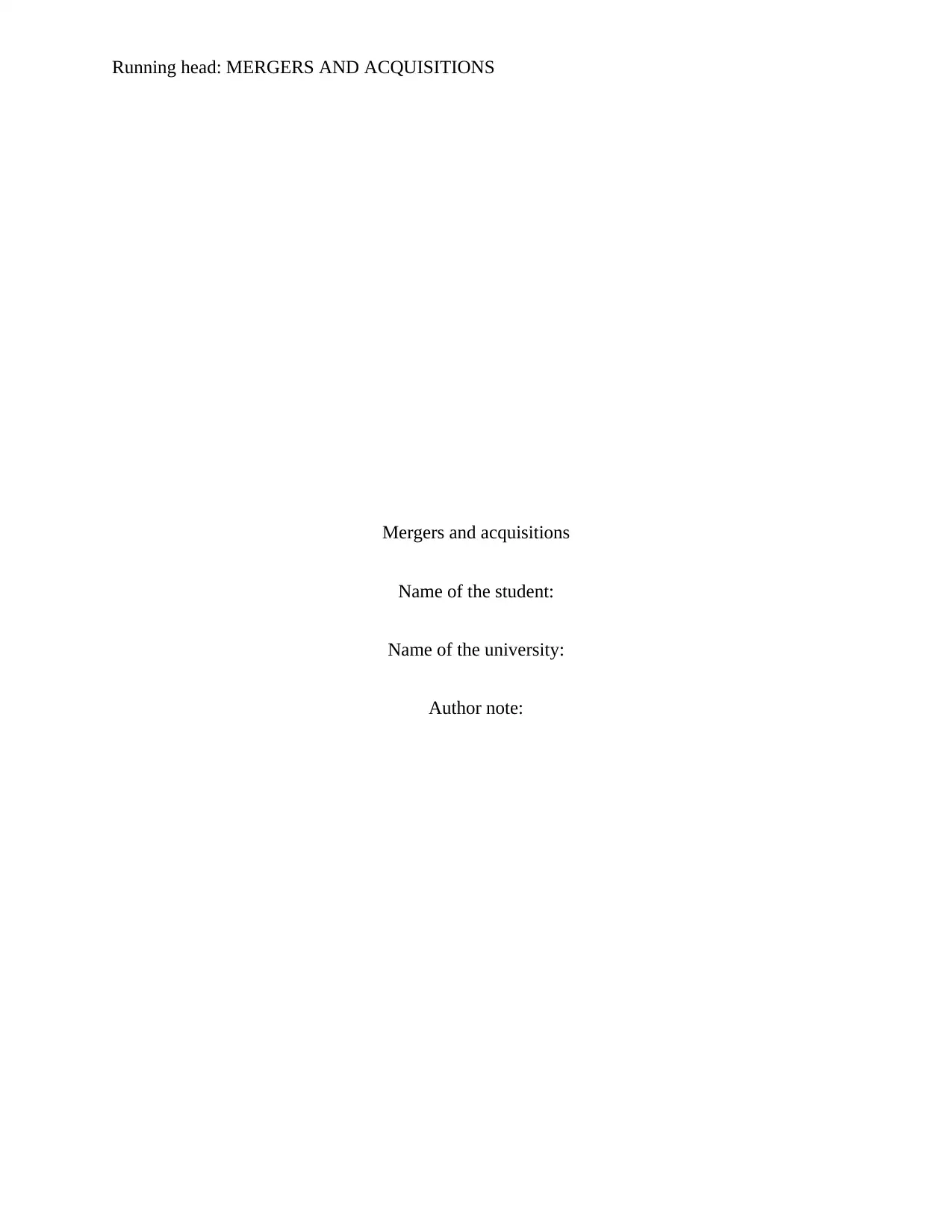
Running head: MERGERS AND ACQUISITIONS
Mergers and acquisitions
Name of the student:
Name of the university:
Author note:
Mergers and acquisitions
Name of the student:
Name of the university:
Author note:
Paraphrase This Document
Need a fresh take? Get an instant paraphrase of this document with our AI Paraphraser
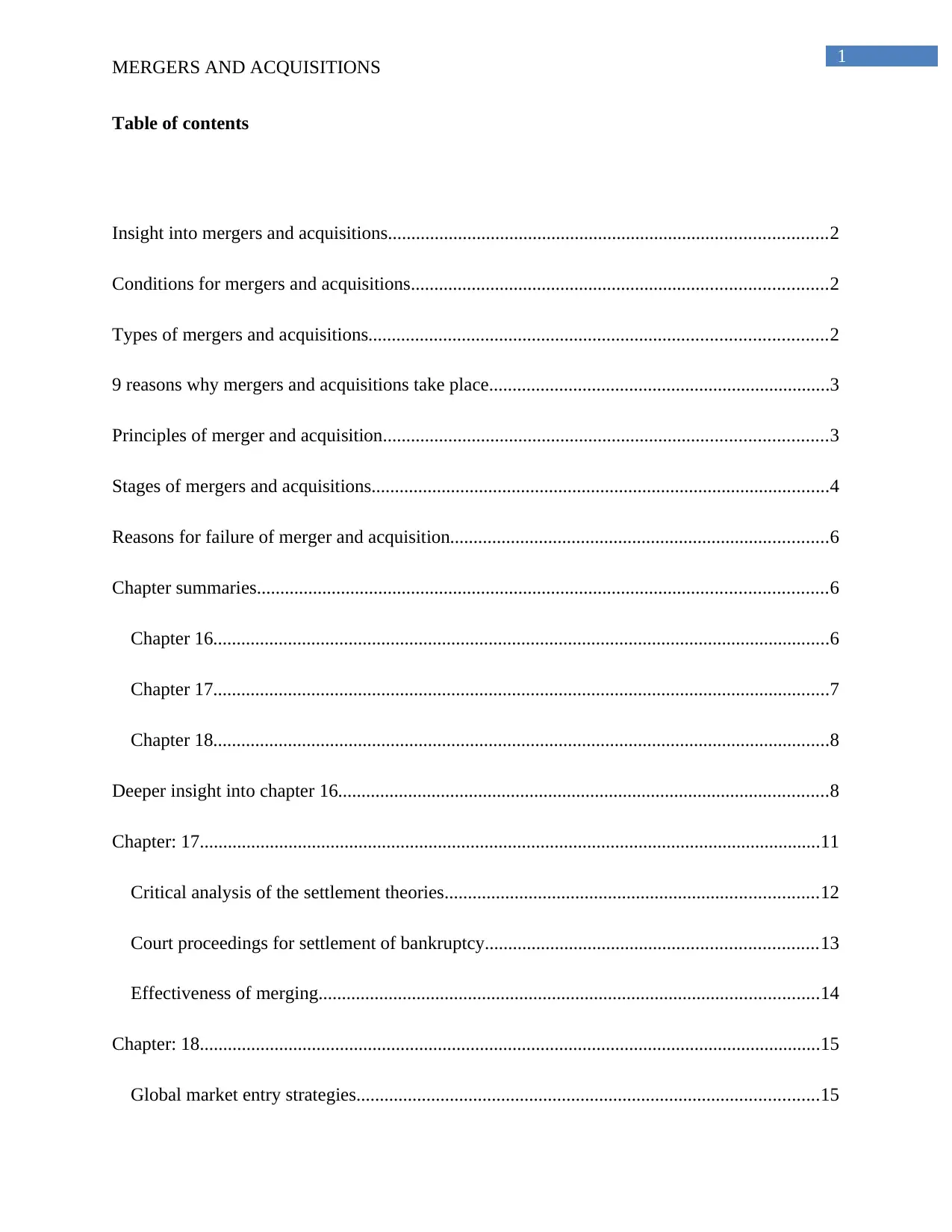
1
MERGERS AND ACQUISITIONS
Table of contents
Insight into mergers and acquisitions..............................................................................................2
Conditions for mergers and acquisitions.........................................................................................2
Types of mergers and acquisitions..................................................................................................2
9 reasons why mergers and acquisitions take place.........................................................................3
Principles of merger and acquisition...............................................................................................3
Stages of mergers and acquisitions..................................................................................................4
Reasons for failure of merger and acquisition.................................................................................6
Chapter summaries..........................................................................................................................6
Chapter 16....................................................................................................................................6
Chapter 17....................................................................................................................................7
Chapter 18....................................................................................................................................8
Deeper insight into chapter 16.........................................................................................................8
Chapter: 17.....................................................................................................................................11
Critical analysis of the settlement theories................................................................................12
Court proceedings for settlement of bankruptcy.......................................................................13
Effectiveness of merging...........................................................................................................14
Chapter: 18.....................................................................................................................................15
Global market entry strategies...................................................................................................15
MERGERS AND ACQUISITIONS
Table of contents
Insight into mergers and acquisitions..............................................................................................2
Conditions for mergers and acquisitions.........................................................................................2
Types of mergers and acquisitions..................................................................................................2
9 reasons why mergers and acquisitions take place.........................................................................3
Principles of merger and acquisition...............................................................................................3
Stages of mergers and acquisitions..................................................................................................4
Reasons for failure of merger and acquisition.................................................................................6
Chapter summaries..........................................................................................................................6
Chapter 16....................................................................................................................................6
Chapter 17....................................................................................................................................7
Chapter 18....................................................................................................................................8
Deeper insight into chapter 16.........................................................................................................8
Chapter: 17.....................................................................................................................................11
Critical analysis of the settlement theories................................................................................12
Court proceedings for settlement of bankruptcy.......................................................................13
Effectiveness of merging...........................................................................................................14
Chapter: 18.....................................................................................................................................15
Global market entry strategies...................................................................................................15

2
MERGERS AND ACQUISITIONS
Influencing factors for cross border merger and acquisition.....................................................16
Conclusion.....................................................................................................................................18
References......................................................................................................................................19
MERGERS AND ACQUISITIONS
Influencing factors for cross border merger and acquisition.....................................................16
Conclusion.....................................................................................................................................18
References......................................................................................................................................19
⊘ This is a preview!⊘
Do you want full access?
Subscribe today to unlock all pages.

Trusted by 1+ million students worldwide
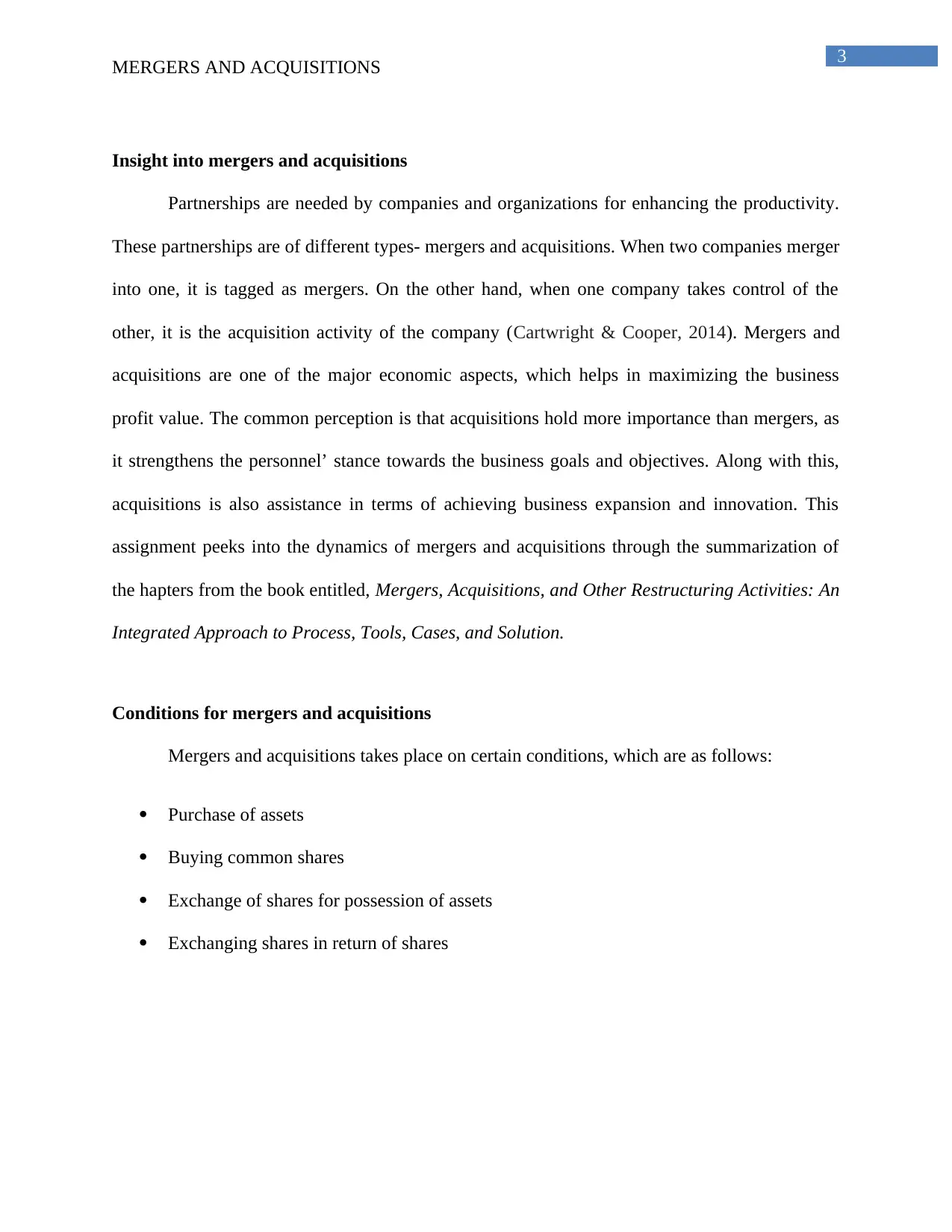
3
MERGERS AND ACQUISITIONS
Insight into mergers and acquisitions
Partnerships are needed by companies and organizations for enhancing the productivity.
These partnerships are of different types- mergers and acquisitions. When two companies merger
into one, it is tagged as mergers. On the other hand, when one company takes control of the
other, it is the acquisition activity of the company (Cartwright & Cooper, 2014). Mergers and
acquisitions are one of the major economic aspects, which helps in maximizing the business
profit value. The common perception is that acquisitions hold more importance than mergers, as
it strengthens the personnel’ stance towards the business goals and objectives. Along with this,
acquisitions is also assistance in terms of achieving business expansion and innovation. This
assignment peeks into the dynamics of mergers and acquisitions through the summarization of
the hapters from the book entitled, Mergers, Acquisitions, and Other Restructuring Activities: An
Integrated Approach to Process, Tools, Cases, and Solution.
Conditions for mergers and acquisitions
Mergers and acquisitions takes place on certain conditions, which are as follows:
Purchase of assets
Buying common shares
Exchange of shares for possession of assets
Exchanging shares in return of shares
MERGERS AND ACQUISITIONS
Insight into mergers and acquisitions
Partnerships are needed by companies and organizations for enhancing the productivity.
These partnerships are of different types- mergers and acquisitions. When two companies merger
into one, it is tagged as mergers. On the other hand, when one company takes control of the
other, it is the acquisition activity of the company (Cartwright & Cooper, 2014). Mergers and
acquisitions are one of the major economic aspects, which helps in maximizing the business
profit value. The common perception is that acquisitions hold more importance than mergers, as
it strengthens the personnel’ stance towards the business goals and objectives. Along with this,
acquisitions is also assistance in terms of achieving business expansion and innovation. This
assignment peeks into the dynamics of mergers and acquisitions through the summarization of
the hapters from the book entitled, Mergers, Acquisitions, and Other Restructuring Activities: An
Integrated Approach to Process, Tools, Cases, and Solution.
Conditions for mergers and acquisitions
Mergers and acquisitions takes place on certain conditions, which are as follows:
Purchase of assets
Buying common shares
Exchange of shares for possession of assets
Exchanging shares in return of shares
Paraphrase This Document
Need a fresh take? Get an instant paraphrase of this document with our AI Paraphraser
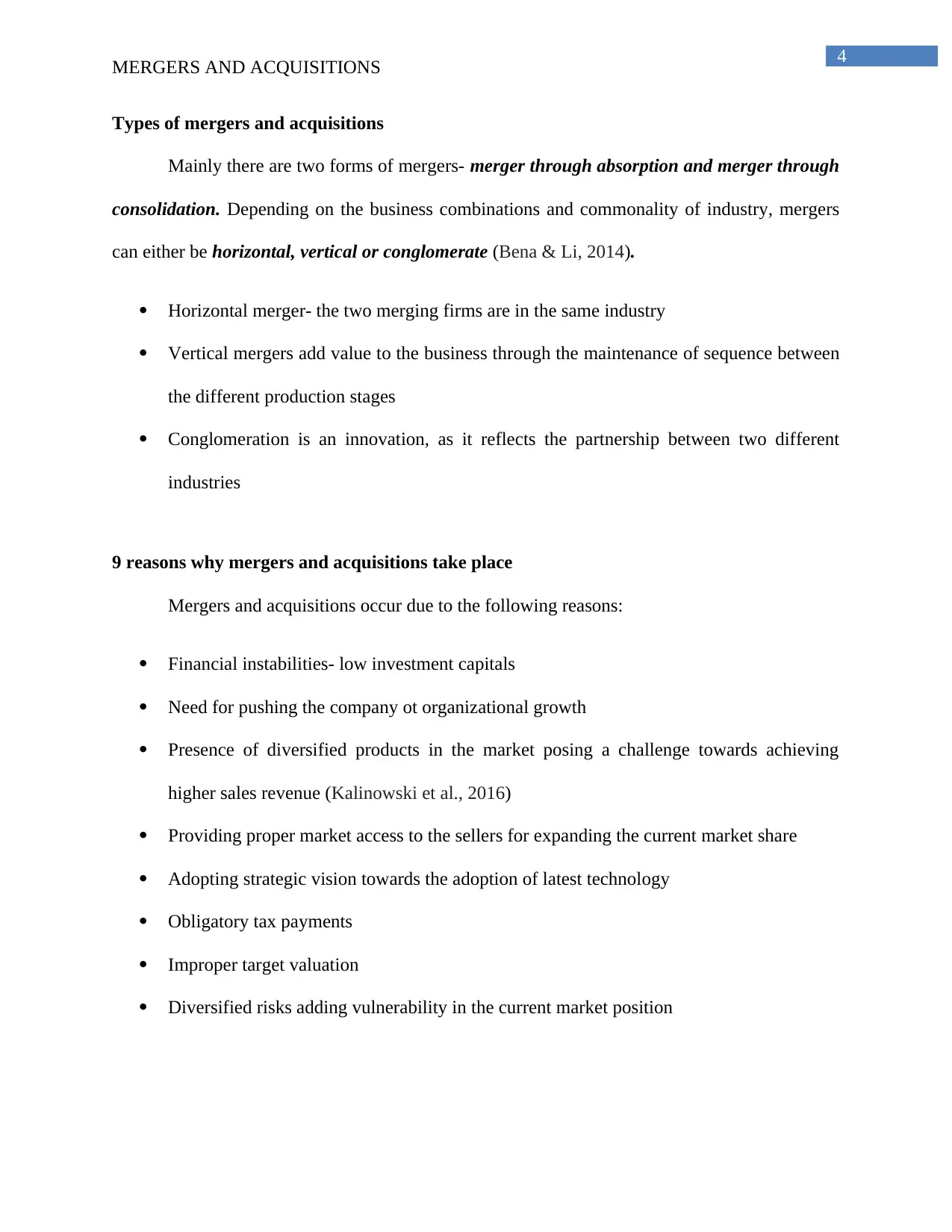
4
MERGERS AND ACQUISITIONS
Types of mergers and acquisitions
Mainly there are two forms of mergers- merger through absorption and merger through
consolidation. Depending on the business combinations and commonality of industry, mergers
can either be horizontal, vertical or conglomerate (Bena & Li, 2014).
Horizontal merger- the two merging firms are in the same industry
Vertical mergers add value to the business through the maintenance of sequence between
the different production stages
Conglomeration is an innovation, as it reflects the partnership between two different
industries
9 reasons why mergers and acquisitions take place
Mergers and acquisitions occur due to the following reasons:
Financial instabilities- low investment capitals
Need for pushing the company ot organizational growth
Presence of diversified products in the market posing a challenge towards achieving
higher sales revenue (Kalinowski et al., 2016)
Providing proper market access to the sellers for expanding the current market share
Adopting strategic vision towards the adoption of latest technology
Obligatory tax payments
Improper target valuation
Diversified risks adding vulnerability in the current market position
MERGERS AND ACQUISITIONS
Types of mergers and acquisitions
Mainly there are two forms of mergers- merger through absorption and merger through
consolidation. Depending on the business combinations and commonality of industry, mergers
can either be horizontal, vertical or conglomerate (Bena & Li, 2014).
Horizontal merger- the two merging firms are in the same industry
Vertical mergers add value to the business through the maintenance of sequence between
the different production stages
Conglomeration is an innovation, as it reflects the partnership between two different
industries
9 reasons why mergers and acquisitions take place
Mergers and acquisitions occur due to the following reasons:
Financial instabilities- low investment capitals
Need for pushing the company ot organizational growth
Presence of diversified products in the market posing a challenge towards achieving
higher sales revenue (Kalinowski et al., 2016)
Providing proper market access to the sellers for expanding the current market share
Adopting strategic vision towards the adoption of latest technology
Obligatory tax payments
Improper target valuation
Diversified risks adding vulnerability in the current market position
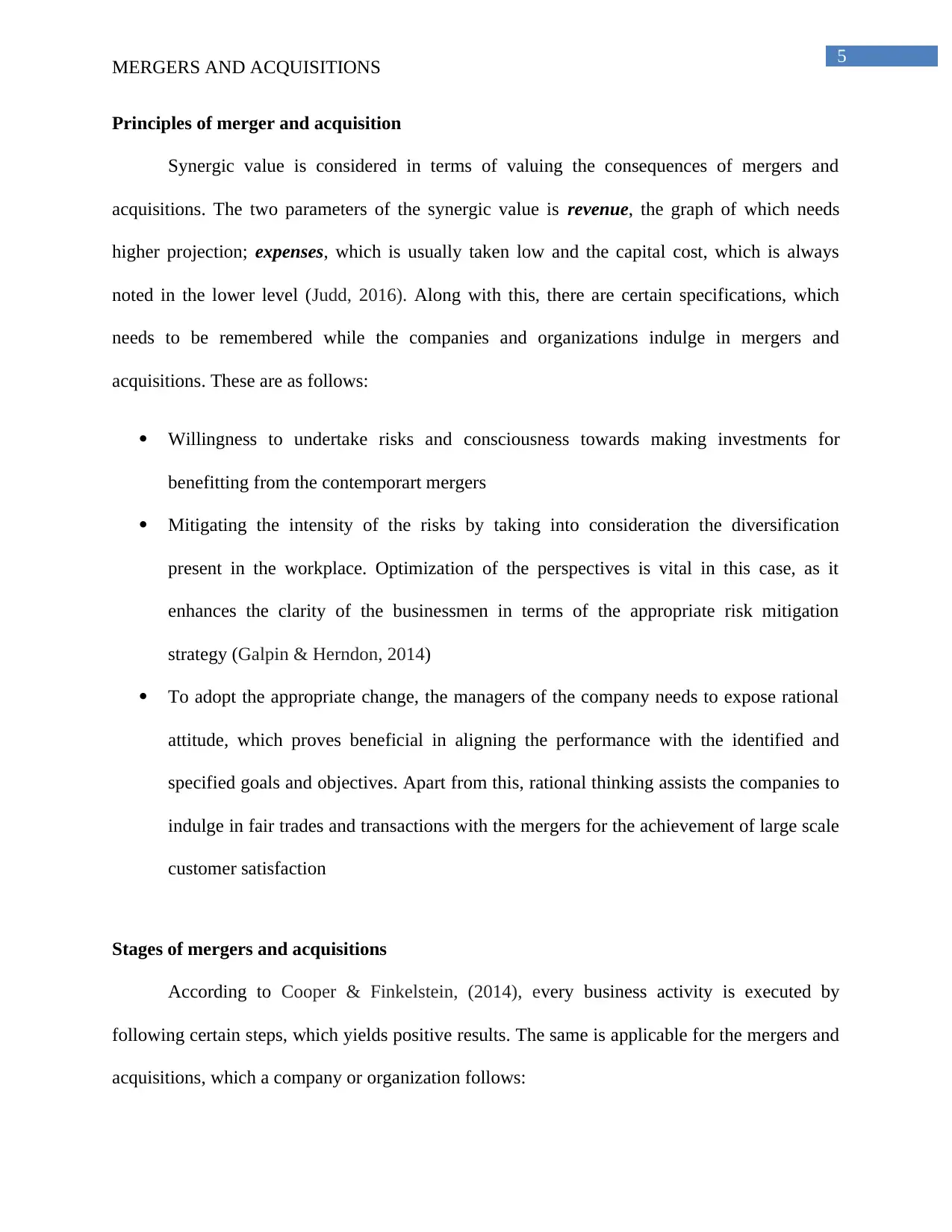
5
MERGERS AND ACQUISITIONS
Principles of merger and acquisition
Synergic value is considered in terms of valuing the consequences of mergers and
acquisitions. The two parameters of the synergic value is revenue, the graph of which needs
higher projection; expenses, which is usually taken low and the capital cost, which is always
noted in the lower level (Judd, 2016). Along with this, there are certain specifications, which
needs to be remembered while the companies and organizations indulge in mergers and
acquisitions. These are as follows:
Willingness to undertake risks and consciousness towards making investments for
benefitting from the contemporart mergers
Mitigating the intensity of the risks by taking into consideration the diversification
present in the workplace. Optimization of the perspectives is vital in this case, as it
enhances the clarity of the businessmen in terms of the appropriate risk mitigation
strategy (Galpin & Herndon, 2014)
To adopt the appropriate change, the managers of the company needs to expose rational
attitude, which proves beneficial in aligning the performance with the identified and
specified goals and objectives. Apart from this, rational thinking assists the companies to
indulge in fair trades and transactions with the mergers for the achievement of large scale
customer satisfaction
Stages of mergers and acquisitions
According to Cooper & Finkelstein, (2014), every business activity is executed by
following certain steps, which yields positive results. The same is applicable for the mergers and
acquisitions, which a company or organization follows:
MERGERS AND ACQUISITIONS
Principles of merger and acquisition
Synergic value is considered in terms of valuing the consequences of mergers and
acquisitions. The two parameters of the synergic value is revenue, the graph of which needs
higher projection; expenses, which is usually taken low and the capital cost, which is always
noted in the lower level (Judd, 2016). Along with this, there are certain specifications, which
needs to be remembered while the companies and organizations indulge in mergers and
acquisitions. These are as follows:
Willingness to undertake risks and consciousness towards making investments for
benefitting from the contemporart mergers
Mitigating the intensity of the risks by taking into consideration the diversification
present in the workplace. Optimization of the perspectives is vital in this case, as it
enhances the clarity of the businessmen in terms of the appropriate risk mitigation
strategy (Galpin & Herndon, 2014)
To adopt the appropriate change, the managers of the company needs to expose rational
attitude, which proves beneficial in aligning the performance with the identified and
specified goals and objectives. Apart from this, rational thinking assists the companies to
indulge in fair trades and transactions with the mergers for the achievement of large scale
customer satisfaction
Stages of mergers and acquisitions
According to Cooper & Finkelstein, (2014), every business activity is executed by
following certain steps, which yields positive results. The same is applicable for the mergers and
acquisitions, which a company or organization follows:
⊘ This is a preview!⊘
Do you want full access?
Subscribe today to unlock all pages.

Trusted by 1+ million students worldwide
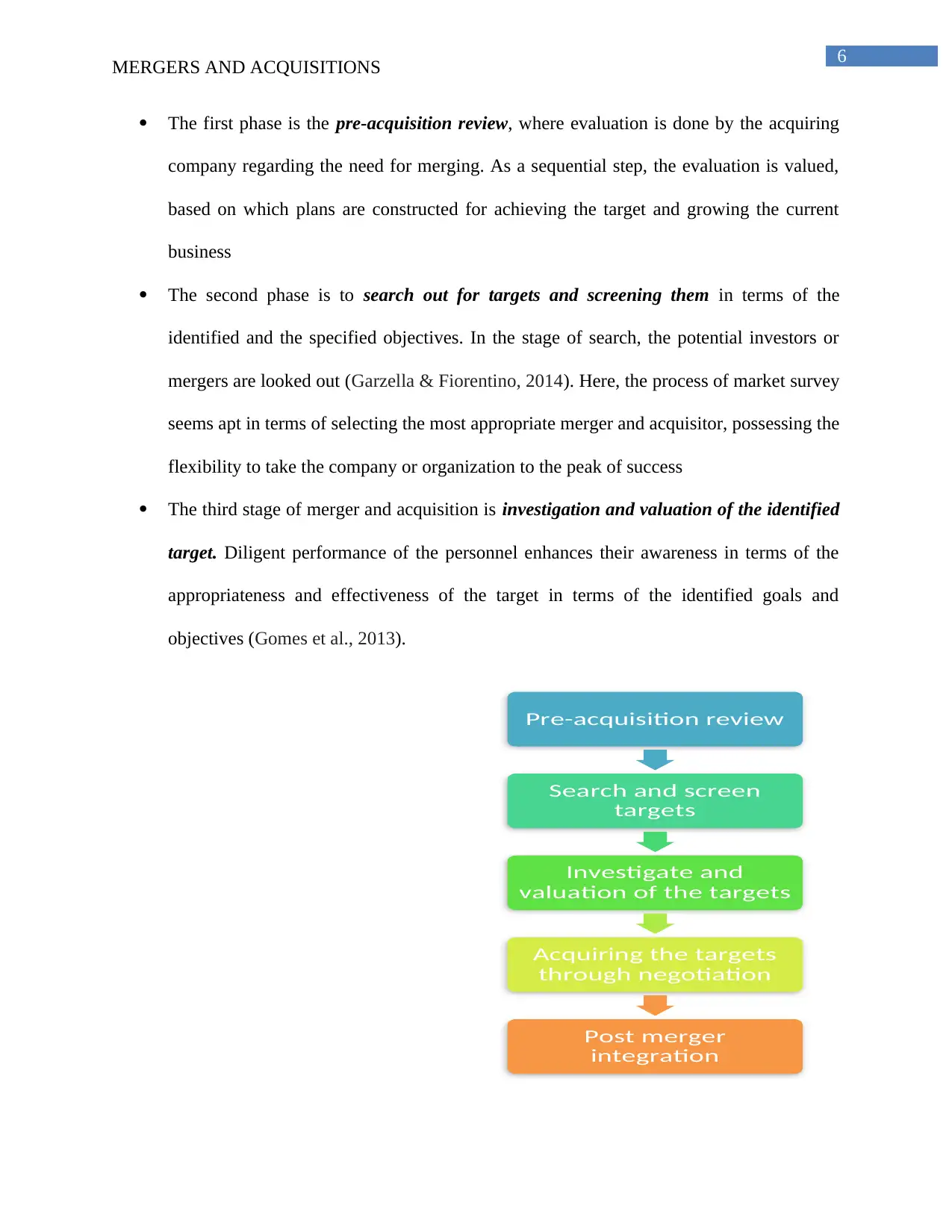
6
MERGERS AND ACQUISITIONS
The first phase is the pre-acquisition review, where evaluation is done by the acquiring
company regarding the need for merging. As a sequential step, the evaluation is valued,
based on which plans are constructed for achieving the target and growing the current
business
The second phase is to search out for targets and screening them in terms of the
identified and the specified objectives. In the stage of search, the potential investors or
mergers are looked out (Garzella & Fiorentino, 2014). Here, the process of market survey
seems apt in terms of selecting the most appropriate merger and acquisitor, possessing the
flexibility to take the company or organization to the peak of success
The third stage of merger and acquisition is investigation and valuation of the identified
target. Diligent performance of the personnel enhances their awareness in terms of the
appropriateness and effectiveness of the target in terms of the identified goals and
objectives (Gomes et al., 2013).
Pre-acquisition review
Search and screen
targets
Investigate and
valuation of the targets
Acquiring the targets
through negotiation
Post merger
integration
MERGERS AND ACQUISITIONS
The first phase is the pre-acquisition review, where evaluation is done by the acquiring
company regarding the need for merging. As a sequential step, the evaluation is valued,
based on which plans are constructed for achieving the target and growing the current
business
The second phase is to search out for targets and screening them in terms of the
identified and the specified objectives. In the stage of search, the potential investors or
mergers are looked out (Garzella & Fiorentino, 2014). Here, the process of market survey
seems apt in terms of selecting the most appropriate merger and acquisitor, possessing the
flexibility to take the company or organization to the peak of success
The third stage of merger and acquisition is investigation and valuation of the identified
target. Diligent performance of the personnel enhances their awareness in terms of the
appropriateness and effectiveness of the target in terms of the identified goals and
objectives (Gomes et al., 2013).
Pre-acquisition review
Search and screen
targets
Investigate and
valuation of the targets
Acquiring the targets
through negotiation
Post merger
integration
Paraphrase This Document
Need a fresh take? Get an instant paraphrase of this document with our AI Paraphraser
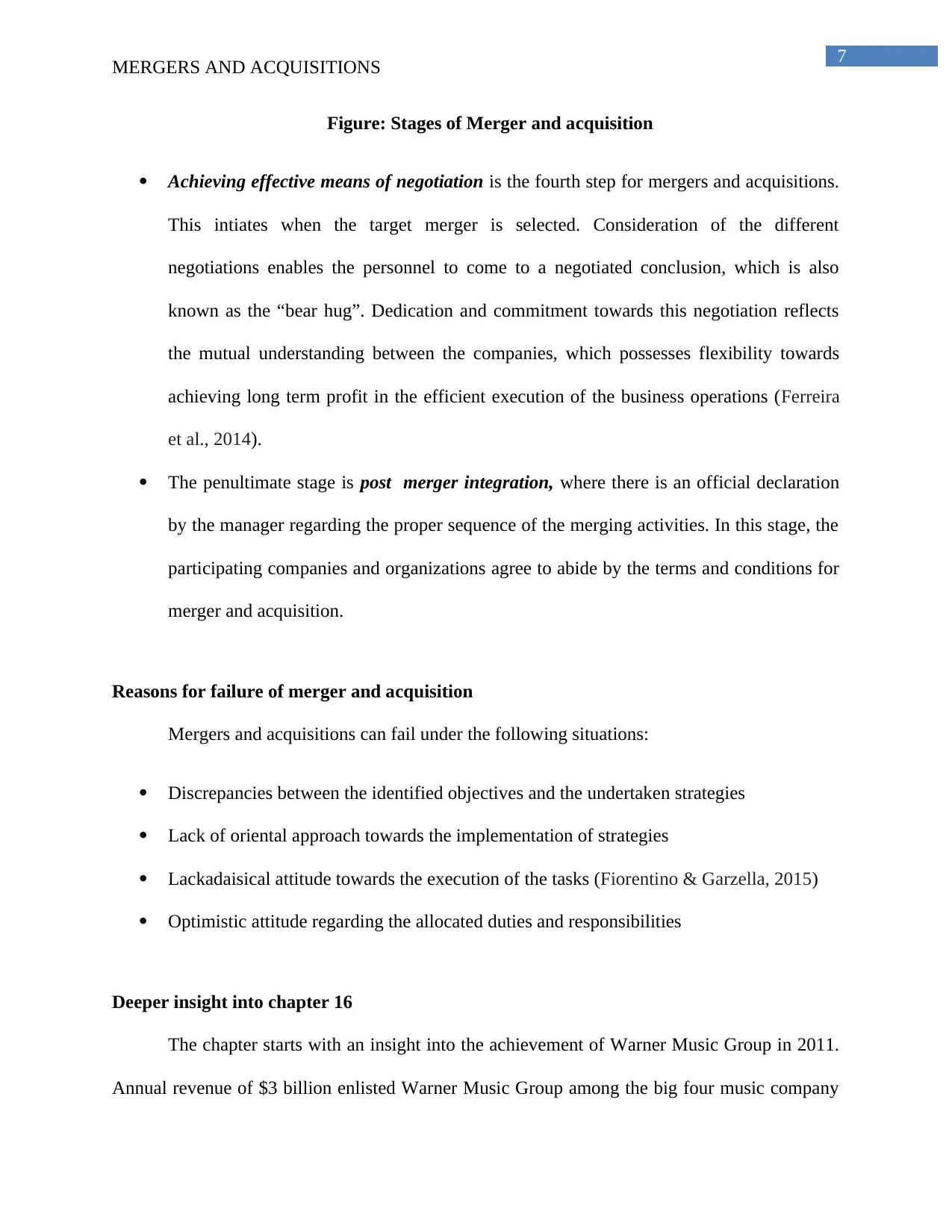
7
MERGERS AND ACQUISITIONS
Figure: Stages of Merger and acquisition
Achieving effective means of negotiation is the fourth step for mergers and acquisitions.
This intiates when the target merger is selected. Consideration of the different
negotiations enables the personnel to come to a negotiated conclusion, which is also
known as the “bear hug”. Dedication and commitment towards this negotiation reflects
the mutual understanding between the companies, which possesses flexibility towards
achieving long term profit in the efficient execution of the business operations (Ferreira
et al., 2014).
The penultimate stage is post merger integration, where there is an official declaration
by the manager regarding the proper sequence of the merging activities. In this stage, the
participating companies and organizations agree to abide by the terms and conditions for
merger and acquisition.
Reasons for failure of merger and acquisition
Mergers and acquisitions can fail under the following situations:
Discrepancies between the identified objectives and the undertaken strategies
Lack of oriental approach towards the implementation of strategies
Lackadaisical attitude towards the execution of the tasks (Fiorentino & Garzella, 2015)
Optimistic attitude regarding the allocated duties and responsibilities
Deeper insight into chapter 16
The chapter starts with an insight into the achievement of Warner Music Group in 2011.
Annual revenue of $3 billion enlisted Warner Music Group among the big four music company
MERGERS AND ACQUISITIONS
Figure: Stages of Merger and acquisition
Achieving effective means of negotiation is the fourth step for mergers and acquisitions.
This intiates when the target merger is selected. Consideration of the different
negotiations enables the personnel to come to a negotiated conclusion, which is also
known as the “bear hug”. Dedication and commitment towards this negotiation reflects
the mutual understanding between the companies, which possesses flexibility towards
achieving long term profit in the efficient execution of the business operations (Ferreira
et al., 2014).
The penultimate stage is post merger integration, where there is an official declaration
by the manager regarding the proper sequence of the merging activities. In this stage, the
participating companies and organizations agree to abide by the terms and conditions for
merger and acquisition.
Reasons for failure of merger and acquisition
Mergers and acquisitions can fail under the following situations:
Discrepancies between the identified objectives and the undertaken strategies
Lack of oriental approach towards the implementation of strategies
Lackadaisical attitude towards the execution of the tasks (Fiorentino & Garzella, 2015)
Optimistic attitude regarding the allocated duties and responsibilities
Deeper insight into chapter 16
The chapter starts with an insight into the achievement of Warner Music Group in 2011.
Annual revenue of $3 billion enlisted Warner Music Group among the big four music company
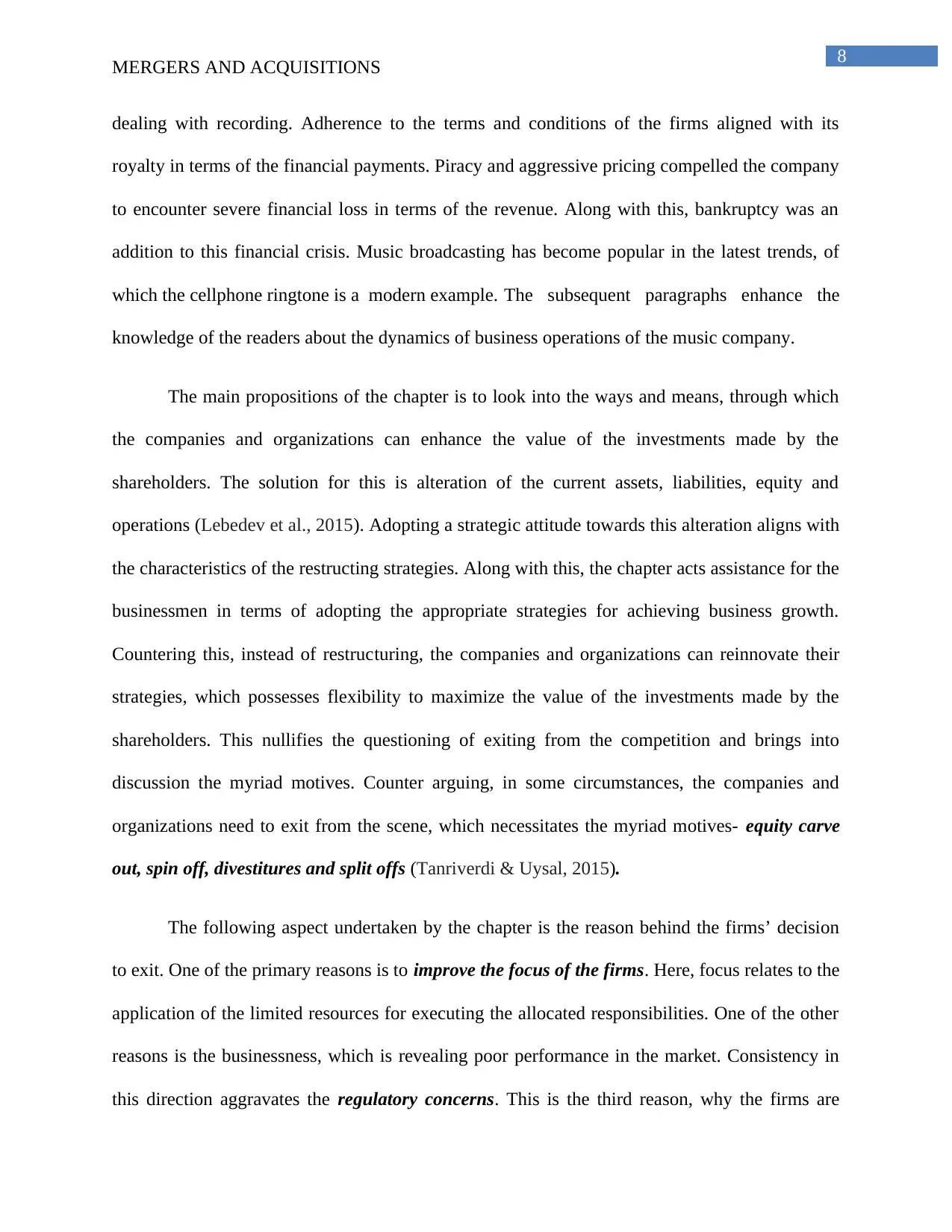
8
MERGERS AND ACQUISITIONS
dealing with recording. Adherence to the terms and conditions of the firms aligned with its
royalty in terms of the financial payments. Piracy and aggressive pricing compelled the company
to encounter severe financial loss in terms of the revenue. Along with this, bankruptcy was an
addition to this financial crisis. Music broadcasting has become popular in the latest trends, of
which the cellphone ringtone is a modern example. The subsequent paragraphs enhance the
knowledge of the readers about the dynamics of business operations of the music company.
The main propositions of the chapter is to look into the ways and means, through which
the companies and organizations can enhance the value of the investments made by the
shareholders. The solution for this is alteration of the current assets, liabilities, equity and
operations (Lebedev et al., 2015). Adopting a strategic attitude towards this alteration aligns with
the characteristics of the restructing strategies. Along with this, the chapter acts assistance for the
businessmen in terms of adopting the appropriate strategies for achieving business growth.
Countering this, instead of restructuring, the companies and organizations can reinnovate their
strategies, which possesses flexibility to maximize the value of the investments made by the
shareholders. This nullifies the questioning of exiting from the competition and brings into
discussion the myriad motives. Counter arguing, in some circumstances, the companies and
organizations need to exit from the scene, which necessitates the myriad motives- equity carve
out, spin off, divestitures and split offs (Tanriverdi & Uysal, 2015).
The following aspect undertaken by the chapter is the reason behind the firms’ decision
to exit. One of the primary reasons is to improve the focus of the firms. Here, focus relates to the
application of the limited resources for executing the allocated responsibilities. One of the other
reasons is the businessness, which is revealing poor performance in the market. Consistency in
this direction aggravates the regulatory concerns. This is the third reason, why the firms are
MERGERS AND ACQUISITIONS
dealing with recording. Adherence to the terms and conditions of the firms aligned with its
royalty in terms of the financial payments. Piracy and aggressive pricing compelled the company
to encounter severe financial loss in terms of the revenue. Along with this, bankruptcy was an
addition to this financial crisis. Music broadcasting has become popular in the latest trends, of
which the cellphone ringtone is a modern example. The subsequent paragraphs enhance the
knowledge of the readers about the dynamics of business operations of the music company.
The main propositions of the chapter is to look into the ways and means, through which
the companies and organizations can enhance the value of the investments made by the
shareholders. The solution for this is alteration of the current assets, liabilities, equity and
operations (Lebedev et al., 2015). Adopting a strategic attitude towards this alteration aligns with
the characteristics of the restructing strategies. Along with this, the chapter acts assistance for the
businessmen in terms of adopting the appropriate strategies for achieving business growth.
Countering this, instead of restructuring, the companies and organizations can reinnovate their
strategies, which possesses flexibility to maximize the value of the investments made by the
shareholders. This nullifies the questioning of exiting from the competition and brings into
discussion the myriad motives. Counter arguing, in some circumstances, the companies and
organizations need to exit from the scene, which necessitates the myriad motives- equity carve
out, spin off, divestitures and split offs (Tanriverdi & Uysal, 2015).
The following aspect undertaken by the chapter is the reason behind the firms’ decision
to exit. One of the primary reasons is to improve the focus of the firms. Here, focus relates to the
application of the limited resources for executing the allocated responsibilities. One of the other
reasons is the businessness, which is revealing poor performance in the market. Consistency in
this direction aggravates the regulatory concerns. This is the third reason, why the firms are
⊘ This is a preview!⊘
Do you want full access?
Subscribe today to unlock all pages.

Trusted by 1+ million students worldwide
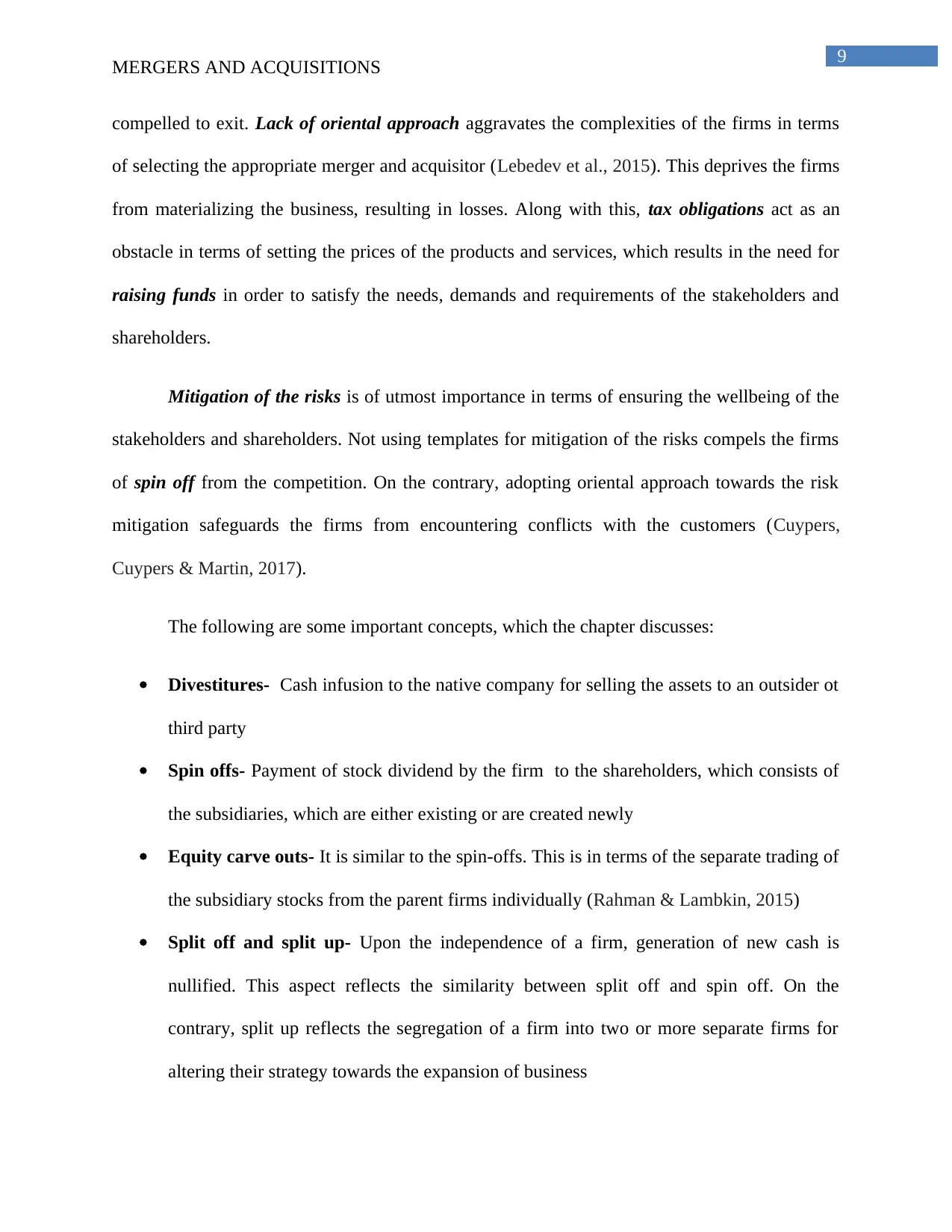
9
MERGERS AND ACQUISITIONS
compelled to exit. Lack of oriental approach aggravates the complexities of the firms in terms
of selecting the appropriate merger and acquisitor (Lebedev et al., 2015). This deprives the firms
from materializing the business, resulting in losses. Along with this, tax obligations act as an
obstacle in terms of setting the prices of the products and services, which results in the need for
raising funds in order to satisfy the needs, demands and requirements of the stakeholders and
shareholders.
Mitigation of the risks is of utmost importance in terms of ensuring the wellbeing of the
stakeholders and shareholders. Not using templates for mitigation of the risks compels the firms
of spin off from the competition. On the contrary, adopting oriental approach towards the risk
mitigation safeguards the firms from encountering conflicts with the customers (Cuypers,
Cuypers & Martin, 2017).
The following are some important concepts, which the chapter discusses:
Divestitures- Cash infusion to the native company for selling the assets to an outsider ot
third party
Spin offs- Payment of stock dividend by the firm to the shareholders, which consists of
the subsidiaries, which are either existing or are created newly
Equity carve outs- It is similar to the spin-offs. This is in terms of the separate trading of
the subsidiary stocks from the parent firms individually (Rahman & Lambkin, 2015)
Split off and split up- Upon the independence of a firm, generation of new cash is
nullified. This aspect reflects the similarity between split off and spin off. On the
contrary, split up reflects the segregation of a firm into two or more separate firms for
altering their strategy towards the expansion of business
MERGERS AND ACQUISITIONS
compelled to exit. Lack of oriental approach aggravates the complexities of the firms in terms
of selecting the appropriate merger and acquisitor (Lebedev et al., 2015). This deprives the firms
from materializing the business, resulting in losses. Along with this, tax obligations act as an
obstacle in terms of setting the prices of the products and services, which results in the need for
raising funds in order to satisfy the needs, demands and requirements of the stakeholders and
shareholders.
Mitigation of the risks is of utmost importance in terms of ensuring the wellbeing of the
stakeholders and shareholders. Not using templates for mitigation of the risks compels the firms
of spin off from the competition. On the contrary, adopting oriental approach towards the risk
mitigation safeguards the firms from encountering conflicts with the customers (Cuypers,
Cuypers & Martin, 2017).
The following are some important concepts, which the chapter discusses:
Divestitures- Cash infusion to the native company for selling the assets to an outsider ot
third party
Spin offs- Payment of stock dividend by the firm to the shareholders, which consists of
the subsidiaries, which are either existing or are created newly
Equity carve outs- It is similar to the spin-offs. This is in terms of the separate trading of
the subsidiary stocks from the parent firms individually (Rahman & Lambkin, 2015)
Split off and split up- Upon the independence of a firm, generation of new cash is
nullified. This aspect reflects the similarity between split off and spin off. On the
contrary, split up reflects the segregation of a firm into two or more separate firms for
altering their strategy towards the expansion of business
Paraphrase This Document
Need a fresh take? Get an instant paraphrase of this document with our AI Paraphraser
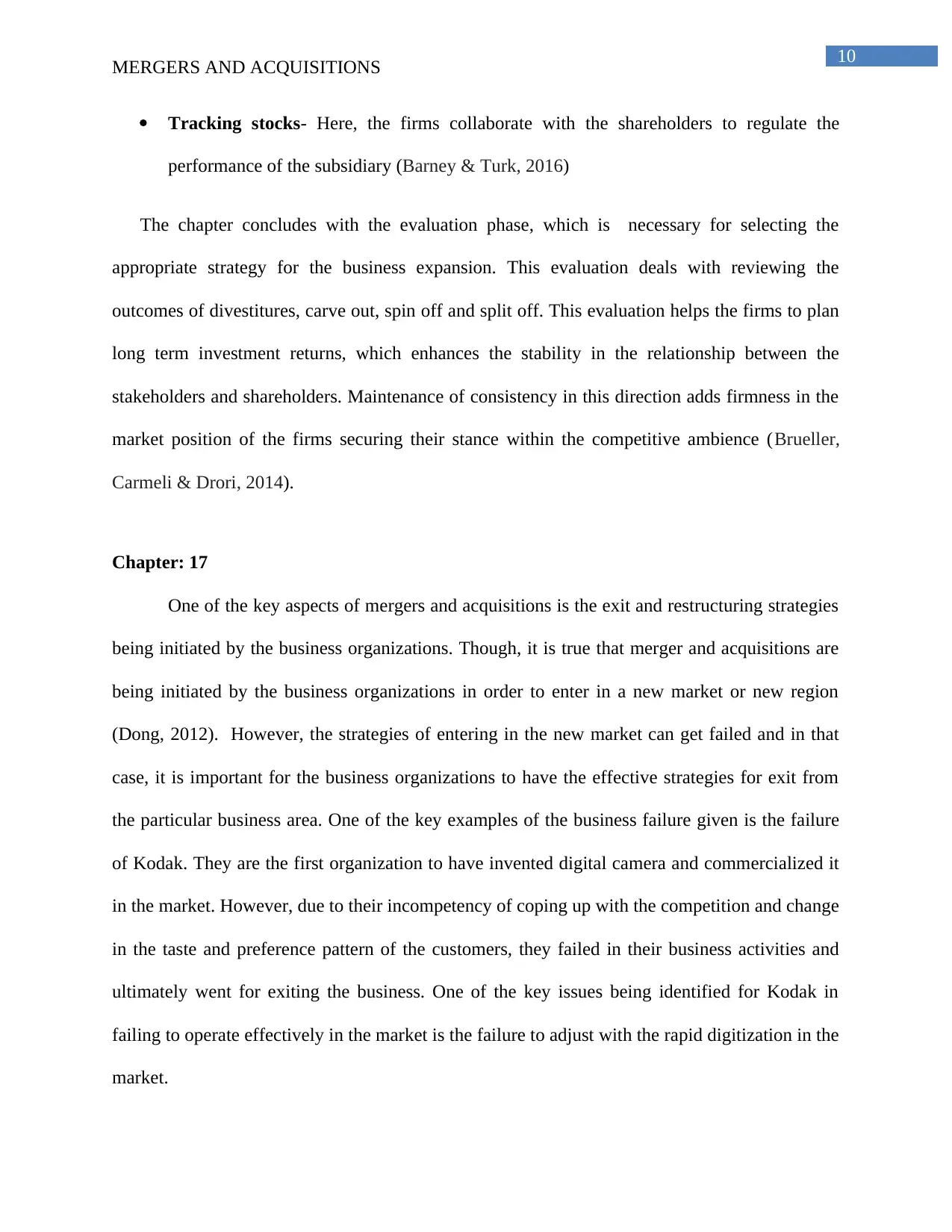
10
MERGERS AND ACQUISITIONS
Tracking stocks- Here, the firms collaborate with the shareholders to regulate the
performance of the subsidiary (Barney & Turk, 2016)
The chapter concludes with the evaluation phase, which is necessary for selecting the
appropriate strategy for the business expansion. This evaluation deals with reviewing the
outcomes of divestitures, carve out, spin off and split off. This evaluation helps the firms to plan
long term investment returns, which enhances the stability in the relationship between the
stakeholders and shareholders. Maintenance of consistency in this direction adds firmness in the
market position of the firms securing their stance within the competitive ambience (Brueller,
Carmeli & Drori, 2014).
Chapter: 17
One of the key aspects of mergers and acquisitions is the exit and restructuring strategies
being initiated by the business organizations. Though, it is true that merger and acquisitions are
being initiated by the business organizations in order to enter in a new market or new region
(Dong, 2012). However, the strategies of entering in the new market can get failed and in that
case, it is important for the business organizations to have the effective strategies for exit from
the particular business area. One of the key examples of the business failure given is the failure
of Kodak. They are the first organization to have invented digital camera and commercialized it
in the market. However, due to their incompetency of coping up with the competition and change
in the taste and preference pattern of the customers, they failed in their business activities and
ultimately went for exiting the business. One of the key issues being identified for Kodak in
failing to operate effectively in the market is the failure to adjust with the rapid digitization in the
market.
MERGERS AND ACQUISITIONS
Tracking stocks- Here, the firms collaborate with the shareholders to regulate the
performance of the subsidiary (Barney & Turk, 2016)
The chapter concludes with the evaluation phase, which is necessary for selecting the
appropriate strategy for the business expansion. This evaluation deals with reviewing the
outcomes of divestitures, carve out, spin off and split off. This evaluation helps the firms to plan
long term investment returns, which enhances the stability in the relationship between the
stakeholders and shareholders. Maintenance of consistency in this direction adds firmness in the
market position of the firms securing their stance within the competitive ambience (Brueller,
Carmeli & Drori, 2014).
Chapter: 17
One of the key aspects of mergers and acquisitions is the exit and restructuring strategies
being initiated by the business organizations. Though, it is true that merger and acquisitions are
being initiated by the business organizations in order to enter in a new market or new region
(Dong, 2012). However, the strategies of entering in the new market can get failed and in that
case, it is important for the business organizations to have the effective strategies for exit from
the particular business area. One of the key examples of the business failure given is the failure
of Kodak. They are the first organization to have invented digital camera and commercialized it
in the market. However, due to their incompetency of coping up with the competition and change
in the taste and preference pattern of the customers, they failed in their business activities and
ultimately went for exiting the business. One of the key issues being identified for Kodak in
failing to operate effectively in the market is the failure to adjust with the rapid digitization in the
market.
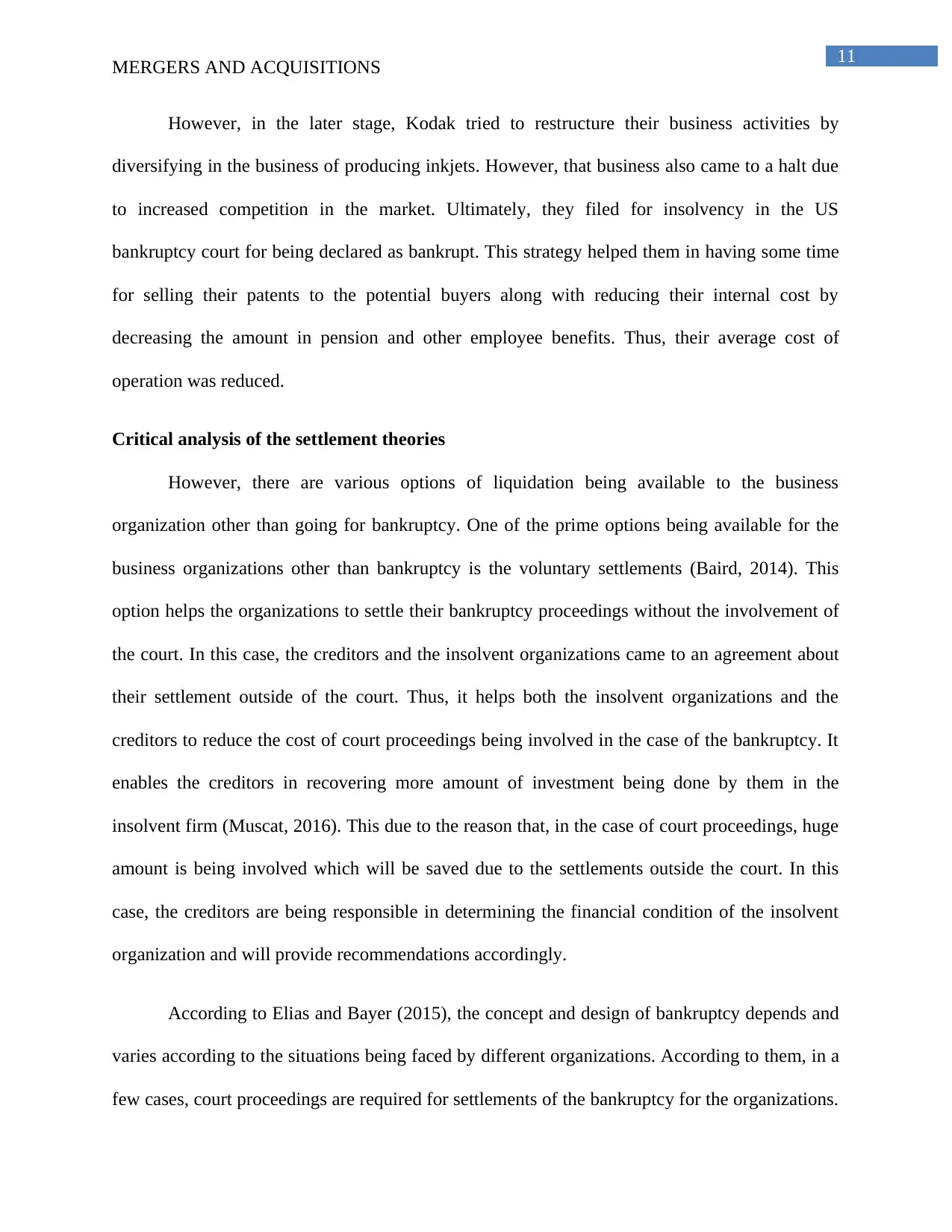
11
MERGERS AND ACQUISITIONS
However, in the later stage, Kodak tried to restructure their business activities by
diversifying in the business of producing inkjets. However, that business also came to a halt due
to increased competition in the market. Ultimately, they filed for insolvency in the US
bankruptcy court for being declared as bankrupt. This strategy helped them in having some time
for selling their patents to the potential buyers along with reducing their internal cost by
decreasing the amount in pension and other employee benefits. Thus, their average cost of
operation was reduced.
Critical analysis of the settlement theories
However, there are various options of liquidation being available to the business
organization other than going for bankruptcy. One of the prime options being available for the
business organizations other than bankruptcy is the voluntary settlements (Baird, 2014). This
option helps the organizations to settle their bankruptcy proceedings without the involvement of
the court. In this case, the creditors and the insolvent organizations came to an agreement about
their settlement outside of the court. Thus, it helps both the insolvent organizations and the
creditors to reduce the cost of court proceedings being involved in the case of the bankruptcy. It
enables the creditors in recovering more amount of investment being done by them in the
insolvent firm (Muscat, 2016). This due to the reason that, in the case of court proceedings, huge
amount is being involved which will be saved due to the settlements outside the court. In this
case, the creditors are being responsible in determining the financial condition of the insolvent
organization and will provide recommendations accordingly.
According to Elias and Bayer (2015), the concept and design of bankruptcy depends and
varies according to the situations being faced by different organizations. According to them, in a
few cases, court proceedings are required for settlements of the bankruptcy for the organizations.
MERGERS AND ACQUISITIONS
However, in the later stage, Kodak tried to restructure their business activities by
diversifying in the business of producing inkjets. However, that business also came to a halt due
to increased competition in the market. Ultimately, they filed for insolvency in the US
bankruptcy court for being declared as bankrupt. This strategy helped them in having some time
for selling their patents to the potential buyers along with reducing their internal cost by
decreasing the amount in pension and other employee benefits. Thus, their average cost of
operation was reduced.
Critical analysis of the settlement theories
However, there are various options of liquidation being available to the business
organization other than going for bankruptcy. One of the prime options being available for the
business organizations other than bankruptcy is the voluntary settlements (Baird, 2014). This
option helps the organizations to settle their bankruptcy proceedings without the involvement of
the court. In this case, the creditors and the insolvent organizations came to an agreement about
their settlement outside of the court. Thus, it helps both the insolvent organizations and the
creditors to reduce the cost of court proceedings being involved in the case of the bankruptcy. It
enables the creditors in recovering more amount of investment being done by them in the
insolvent firm (Muscat, 2016). This due to the reason that, in the case of court proceedings, huge
amount is being involved which will be saved due to the settlements outside the court. In this
case, the creditors are being responsible in determining the financial condition of the insolvent
organization and will provide recommendations accordingly.
According to Elias and Bayer (2015), the concept and design of bankruptcy depends and
varies according to the situations being faced by different organizations. According to them, in a
few cases, court proceedings are required for settlements of the bankruptcy for the organizations.
⊘ This is a preview!⊘
Do you want full access?
Subscribe today to unlock all pages.

Trusted by 1+ million students worldwide
1 out of 24
Related Documents
Your All-in-One AI-Powered Toolkit for Academic Success.
+13062052269
info@desklib.com
Available 24*7 on WhatsApp / Email
![[object Object]](/_next/static/media/star-bottom.7253800d.svg)
Unlock your academic potential
Copyright © 2020–2025 A2Z Services. All Rights Reserved. Developed and managed by ZUCOL.





